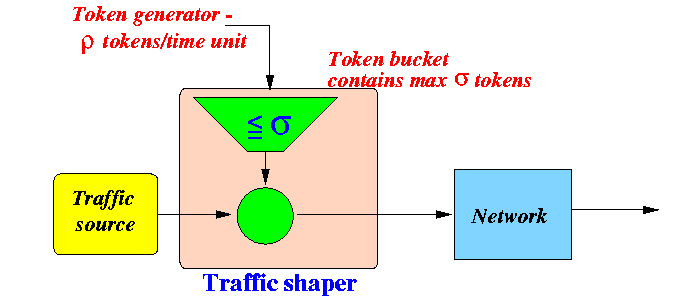- The goal of a computer network is
not simply
send a packet from point A
to point B
- The holy grail of computer network is to
send a packet from point A to point B
with a certain service guarantee
- Examples of service guarantee:
- maximum delay
- minimum throughput
- no packet loss (due to buffer overflow)
- FACT:
-
You cannot design
a system with limited resources that can provide
any service guarantee if the demand is unlimited...
- For example, you cannot provide guarantee against packet loss
if you do not limit bandwidth demand
(Because if you allow unlimited bandwidth use, sooner or later, you will run out of bandwidth and the network starts dropping packets...)
- So, one of the
necessary requirement
in providing guarantees for quality of service
is:
Impose some constraint on the input traffic - For example, if connection desires
some guarantee on the
maximum end-to-end delay time
(or other type of guarantees),
then the sender's transmission rate
conform to some imposed limits
before the
maximum end-to-end delay time guarantee can be met
If the transmission rate of the connection exceeds the imposed transmission rate, then the network will not be able to guarantee the promised end-to-end delay (or other type of guarantees)
- Packet transmission rate from a source varies over time and
is very bursty in nature...
Bursty traffic is packet transmission which a large number of packets is sent in a short time and then for some time, there is no transmission, and so on.
- Bursty traffic is very detrimental for flow and congestion
control; and equally detrimental research into providing
quality of service guarantee to such a flow.
Researchers realise that in order to provide any guarantee to flows, there must be some limitation on burstiness - which is how much data a flow can send "instantaneously"
- To reduce the variance in traffic burstiness,
reseach in traffic shaping has developed
a number of traffic shapers that can be used
to reduce traffic burstiness.
- A traffic shapers is a rate controller mechanism
placed between the traffic source and the network entry:

- A very popular traffic shaper is the leaky bucket rate controller
- The Leaky Bucket rate controller is determined by
2 parameters: (σ, ρ)
- σ = maximum burst size
- ρ = maximum sustained transmission rate
- A Leaky Bucket rate controller can best be understood
using the following mechanical device:
- The token bucket can hold a maximum of σ tokens
- The token genarator continuously generate tokens at a rate of ρ tokens per time unit

- The traffic shaper requires the availability of
one token to transmit one byte of
data:
- If the traffic source wants to transmit a packet of size
S and there are enough tokens in the bucket,
the packet is transmitted and
S tokens are removed from the token bucket.
- If the traffic source wants to transmit a packet of size S and there are not enough tokens in the bucket, then the packet transmission is delayed until S tokens are available in the bucket.
- If the traffic source wants to transmit a packet of size
S and there are enough tokens in the bucket,
the packet is transmitted and
S tokens are removed from the token bucket.
- To appreciate what a rate controller can do for us,
answer the answer to the following question:
-
What is the maximum amount of data transmitted by a traffic source
in some interval
[t1, t2] ?
- Without any traffic shaper, your answer is:
-
C*(t2 - t1)
where C is the maximum link speed.
If we want to provide any guarantees in the network, we have to consider the worst case scenario which is every source transmitting at link speed
It would be immensely costly to provide guarantees....
- If a traffic source is rate controlled by a
leaky bucket, the maximum amount of data transmitted
is:
-
σ + ρ*(t2 - t1)
Because every byte transmitted requires a token, the maximum number of tokens that are available for use in the interval is σ + ρ*(t2 - t1)
(The maximum is reached when the bucket was full at t1: σ. During interval [t1, t2], ρ*(t2 - t1) are generated. So maximum number of tokens that are available for use in the interval is the sum of these 2 values...)